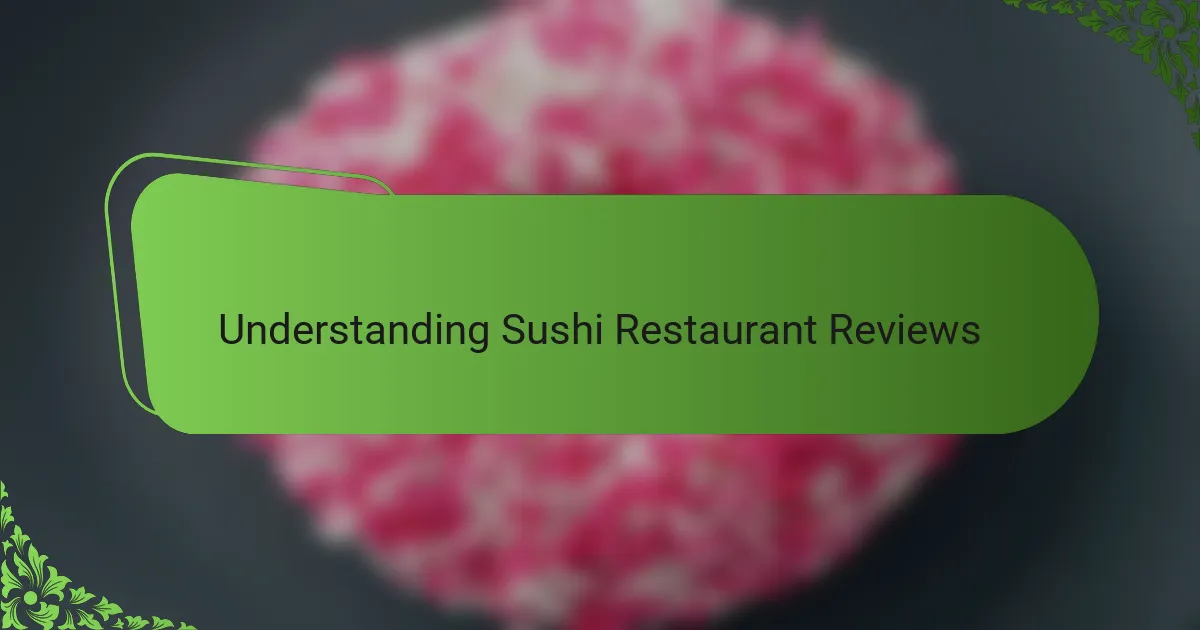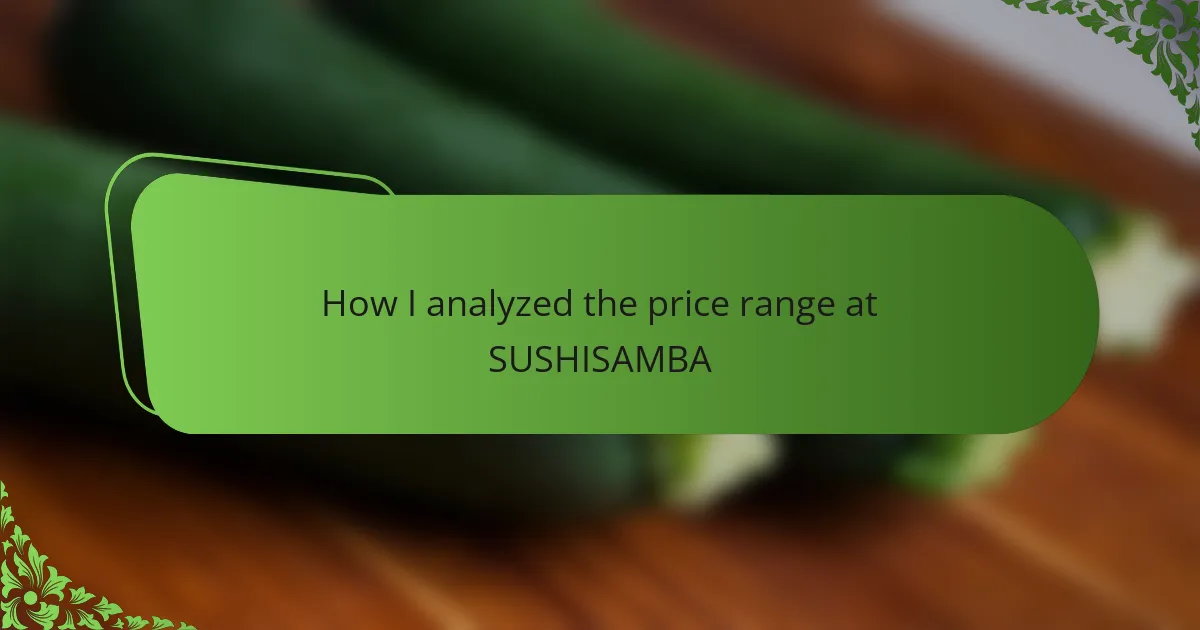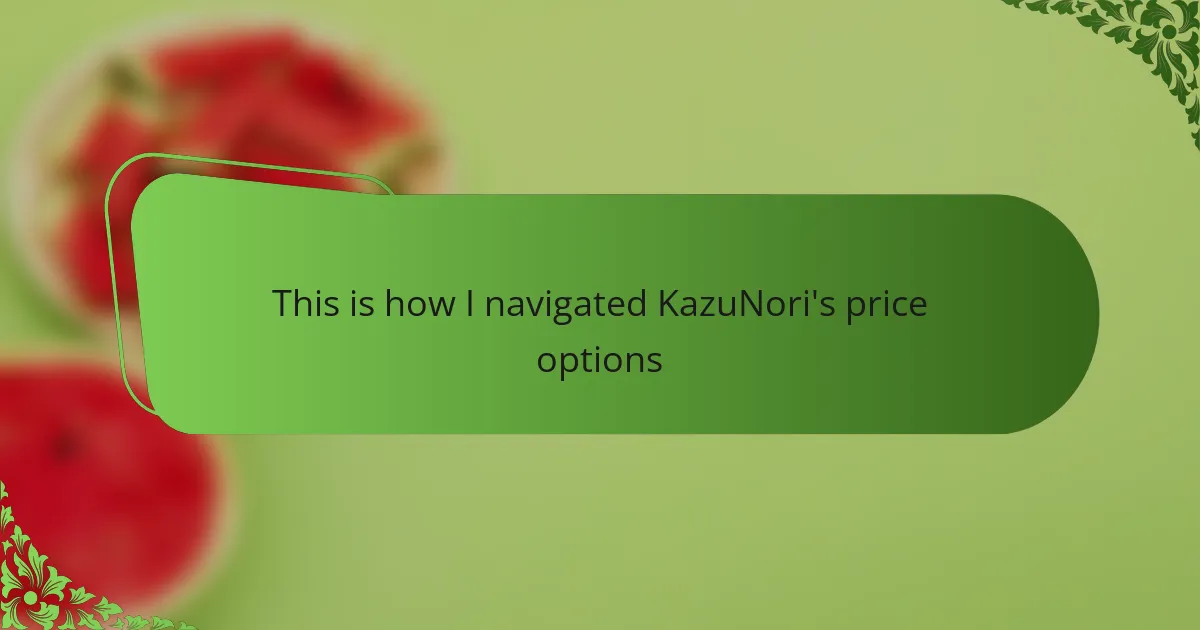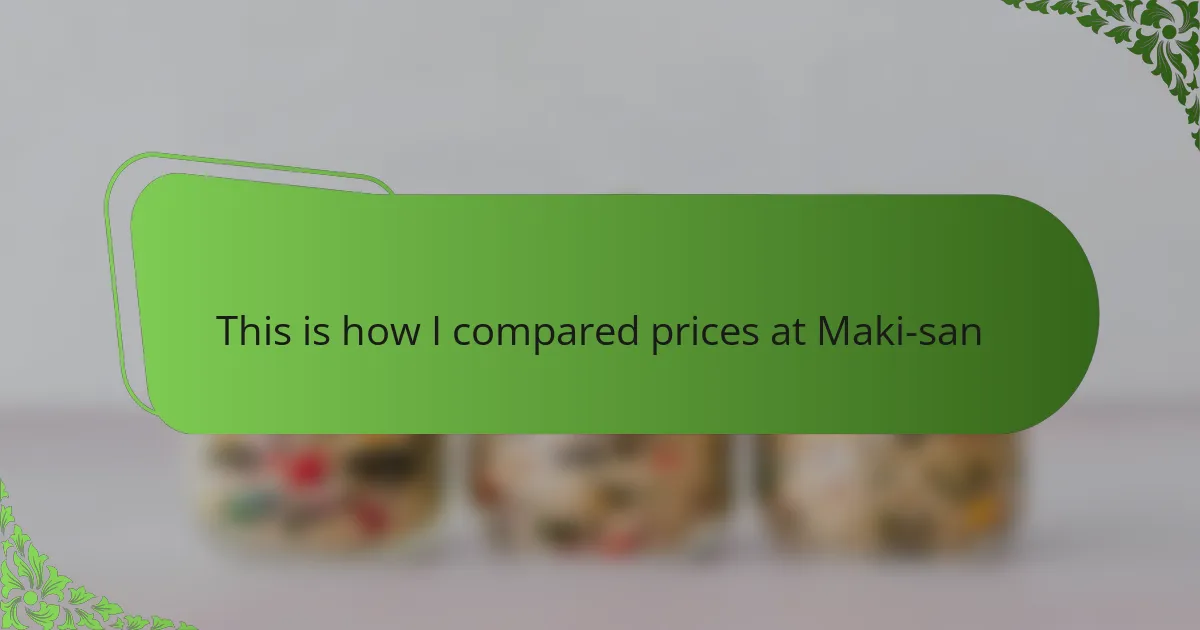Key takeaways
- Sushi restaurant reviews should focus on the complete dining experience, including ambiance, service, and presentation, rather than just menu prices.
- Pricing in sushi often reflects the quality of ingredients, chef’s skill, and the overall dining environment, which can justify higher costs.
- SUSHISAMBA offers a range of pricing options, balancing accessible small plates with elevated dishes, catering to various budgets.
- Sharing dishes is an effective budgeting strategy that enhances the social aspect of dining while allowing for a more diverse menu experience.

Understanding sushi restaurant reviews
When I read sushi restaurant reviews, I always look for more than just the menu prices—I want to understand the overall dining experience. Does the ambiance match the quality of the sushi? Are the service and presentation worth the price? These questions help me see beyond numbers.
Sometimes, a review captures the feeling of being in the restaurant so well that I almost taste the freshness of the fish or hear the clink of glasses. It’s those vivid details that make reviews truly valuable. Have you ever felt like a review transported you straight to the sushi bar before even stepping inside?
I believe that understanding sushi reviews means looking at the whole picture—price, quality, atmosphere, and service together. It’s like piecing together a story that guides your expectations and helps you decide if a place like SUSHISAMBA fits what you’re after. Don’t you find it’s more helpful that way?

Key factors in sushi pricing
Sushi pricing often hinges on the freshness and rarity of ingredients. When I visited SUSHISAMBA, I noticed that premium cuts like otoro or uni came with a higher price tag, which made me wonder—how much does sourcing such exquisite seafood affect the bill? From my experience, it’s clear that quality ingredients justify those numbers.
Another big factor is the chef’s skill and creativity. I’ve sat at sushi bars where the artistry of the chef transformed simple fish into edible masterpieces, and that skill isn’t cheap. Have you ever felt that a beautifully crafted roll or nigiri made you willing to pay a little extra? That’s the magic behind pricing here.
Lastly, the dining environment plays a subtle yet significant role. A stylish setting with attentive service at SUSHISAMBA adds to the overall experience, which shows up on the check. I often think, can the ambiance really change how we value what’s on our plate? From what I’ve seen, it absolutely does.

Overview of SUSHISAMBA menu prices
When I first looked over SUSHISAMBA’s menu prices, I noticed a wide range that seemed to reflect both casual bites and high-end dishes. Some small plates and appetizers were surprisingly approachable, while signature rolls and specialty items leaned toward the pricier side. It made me think about how the menu balances options for different budgets without losing its sense of luxury.
One thing that stood out to me was how shareable dishes like sushi platters and skewers came with a price that encouraged group dining, which felt smart. Have you ever found yourself hesitating at a sushi spot because of single servings but then relaxed seeing more affordable shared options? That definitely played a part in how I saw SUSHISAMBA’s value.
What really intrigued me was the way the prices seemed to match the restaurant’s vibrant and upscale vibe. It’s one thing to see a price tag, but another to feel that you’re paying for an experience beyond just food. Personally, that made me more curious about how each dish would deliver on taste and presentation.

Methods used for price analysis
To analyze SUSHISAMBA’s price range, I started by comparing individual dish prices across their menu, noting patterns between appetizers, specialty rolls, and larger shared plates. This hands-on approach helped me see where the affordable choices end and the premium offerings begin—have you ever done a price walkthrough like this to get a true feel for a restaurant’s range?
Next, I looked at portion sizes and ingredients listed to connect price with value. For example, noticing that some sashimi selections featured rare seafood made me appreciate why those items were pricier—it’s not just about quantity but the quality behind the numbers. Don’t you find that understanding what goes into a dish makes the cost feel more justified?
Finally, I factored in the dining context—how atmosphere and service might influence prices beyond the menu itself. By reflecting on my experience at SUSHISAMBA, I asked myself: does the overall vibe elevate what you pay for? For me, it does, and considering this helped round out my analysis beyond just dollar amounts.

Personal experience with SUSHISAMBA prices
When I first got the bill at SUSHISAMBA, I was pleasantly surprised that the prices, while leaning toward the higher side, felt justified by the quality and creativity on my plate. I remember hesitating for a moment, wondering if I was getting enough value, but each bite quickly erased any doubts. Have you ever had that moment when the first taste convinces you the price was worth it?
One thing that stayed with me was how the pricing encouraged me to share dishes rather than order solo. It made the experience feel more social and less transactional, which I appreciated. Isn’t it interesting how a menu’s price structure can shape the entire vibe of a meal?
Looking back, I think SUSHISAMBA’s price range felt like a promise—a promise of an elevated dining moment rather than just sushi for the sake of eating. That mindset changed how I approached the bill and made me feel more connected to what I was paying for. Don’t you think prices carry more meaning when tied to a memorable experience?

Comparing SUSHISAMBA price range
When I compared SUSHISAMBA’s price range to other sushi spots I’ve visited, one thing stood out—the balance between accessible small plates and indulgent specialties. It wasn’t just about being expensive or cheap; it was how the menu invited me to customize my experience depending on my mood and budget. Have you noticed how having that flexibility makes dining feel more welcoming rather than intimidating?
I also thought about how the price points supported that vibrant, upscale atmosphere without feeling over the top. It reminded me of times I’ve paid more elsewhere but left wondering if the meal truly lived up to the cost. With SUSHISAMBA, the prices seemed to mirror the quality and creativity on the plate, which made me feel like I was investing in something worthwhile.
Looking at it from a practical angle, sharing dishes helped stretch the value without sacrificing variety or taste. I found myself comparing this approach to other sushi restaurants where portions and prices demanded solo orders, which sometimes felt limiting. Don’t you find that sharing plates can turn a meal into a more engaging, social experience that justifies the price more naturally?

Tips for budgeting at sushi restaurants
One budgeting tip I always follow at sushi restaurants is to look for shareable dishes, like platters or skewers. At SUSHISAMBA, I found that splitting these options with friends not only made the experience more social but also helped me enjoy a wider variety without overspending. Have you ever noticed how sharing plates can turn a potentially pricey meal into a fun, cost-effective outing?
I also pay close attention to appetizers and smaller plates that offer a taste of the menu without the hefty price tag of specialty rolls. During my visit, I found some surprising gems here that satisfied my craving without stretching my budget too far. Have you ever been pleasantly surprised by discovering affordable bites that still felt special?
Finally, I think it’s important to balance indulgence with practicality. Choosing a few signature items rather than ordering everything on the menu helped me savor the best of SUSHISAMBA while keeping the bill reasonable. From my experience, having a clear plan before ordering can make all the difference—do you usually map out your sushi choices to avoid sticker shock?



